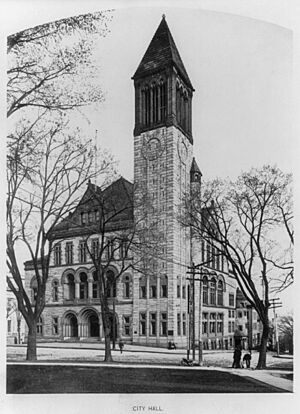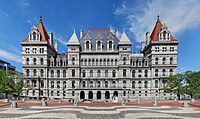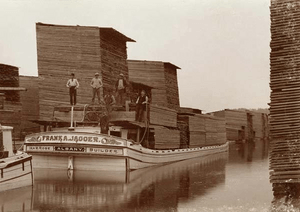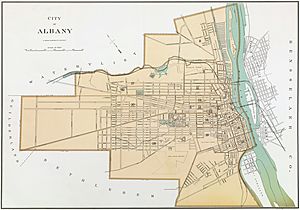History of Albany, New York (1860–1900) facts for kids
The history of Albany, New York from 1860 to 1900 was a time of big changes and growth for the city. This period covers the years just before the Civil War and goes all the way to the start of the 20th century. Albany was a busy place, known for its important role in transportation, business, and industry.
Albany's success in the 1800s was largely due to its excellent location for transportation. But industries and businesses were also very important. Because many people in Albany had Dutch and German backgrounds, beer became a huge product. For example, Beverwyck Brewery was a famous beer company that lasted until 1972.
The city's spot at the end of the Erie Canal meant it could easily get raw materials and sell goods to people in the west. Albany was also famous for its publishing companies, printing many books. For much of the 1800s, Albany printed more books than any city except Boston.
Iron factories also brought many immigrants to Albany. You can still see beautiful wrought-iron designs on old buildings today. However, the iron industry started to slow down by the 1890s. This was partly because of new costs from worker unions and new iron mines opening far away in Minnesota.
Besides beer and books, Albany also traded a lot of furs, wheat, meat, and lumber. By 1865, there were nearly 4,000 sawmills around Albany. The Albany Lumber District became the biggest lumber market in the whole country.
Albany was also a center for banks. The Bank of Albany, founded in 1792, was one of the first banks in New York. Other major banks like Albank, KeyBank, and Norstar Bank also started here. Even American Express began in Albany in 1850 as a business that delivered mail and goods.
In 1871, some parts of Albany's western side were given to the nearby town of Guilderland. In exchange, Albany gained land from the towns of Bethlehem and Watervliet. Later, in 1910, some of the land given to Guilderland was returned to Albany, setting up the city's western border as it is today.
Contents
City Life and Changes (1860-1900)


This period saw many changes in Albany, from new leaders to new buildings and ways to get around.
Mayors and City Government
In 1860, George Thacher became mayor. Two years later, Eli Perry was elected mayor. He was reelected in 1864. In 1866, George Thacher was elected mayor again. He later became the first mayor to have the power to veto (reject) decisions made by the Common Council.
In 1868, Charles Bleecker became mayor. In 1874, George Thacher resigned, and Edmund Judson was elected. He was the second Republican mayor of Albany and the first to be chosen directly by the people.
Anthony Banks became mayor in 1876. In 1878, Michael Nicholas Nolan was elected mayor. He was important because he was the first Irish and first Catholic mayor of Albany. After some court decisions, John Swinburne became mayor in 1883.
Later mayors included Anthony Banks (again in 1884), John Thacher (in 1886 and 1896), Edward Maher (in 1888), James Manning (in 1890 and 1892), Oren Wilson (in 1894), Thomas Van Alstyne (in 1898), and James Blessing (in 1900).
Important Inventions and Buildings
In 1860, George Washington Hough invented the recording barometer while working at the Dudley Observatory in Albany. This device helped measure air pressure changes.
In 1864, the Albany Railway Company started its first horse car service. These horse-drawn trolleys carried people around the city. The Livingston Avenue Railroad Bridge, an important railway bridge, was finished in 1866.
In 1868, Albany became its own Episcopal diocese, a church region. William Croswell Doane was chosen as its first bishop. In 1869, Christian Brothers Academy, a school, was started.
The Maiden Lane Bridge over the Hudson River was completed in 1871, allowing trains to cross the river. In 1871, Washington Park opened, giving residents a beautiful green space. Its lake, bridge, and lakehouse were finished in 1875.

The first Albany High School was finished in 1876. In 1878, the Kenmore Hotel opened, founded by Adam Blake, a former slave. This building still stands today.
In 1879, the old City Hall burned down. Electric lighting came to Albany's streets in 1881, and the current City Hall building was completed that same year.
In 1883, the West Shore Railroad connected Albany to New York City and Syracuse, and later to Buffalo. The cornerstone for the Cathedral of All Saints was laid in 1884.
Construction on the Washington Avenue Armory began in 1889. In 1890, the Hawk Street Viaduct was completed. This bridge allowed traffic to cross over Sheridan Hollow, connecting different parts of the city.
The Albany Times-Union newspaper was first published in 1892. In 1893, the Moses statue was placed in Washington Park. In 1896, the Northern Boulevard bridge was built.
In 1898, a second bridge was built over Sheridan Hollow, carrying Knox Street (now Henry Johnson Boulevard).
The New York State Capitol
The current State Capitol building, which started being built in 1867, was finally finished in 1899. Governor Theodore Roosevelt declared it complete. This grand building was inspired by the Paris City Hall and was the most expensive government building of its time, costing $25 million. It has famous features like its "Million Dollar Staircase."
In 1899, the first automobile arrived in Albany. It was steam-powered and owned by Archibald Dederick. In 1900, the Chamber of Commerce was organized, helping local businesses.



